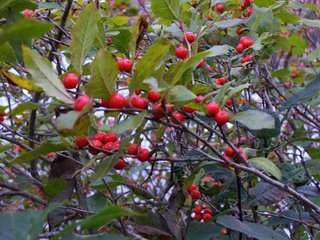 Alex and I drove over to Kettle Pond yesterday afternoon to get some air and take Karl, the wonder dog, for a walk. Karl likes the autumn air and has his snifffer working overtime. We usually do not tell people what kind of dog he is or the fact that his favorite sport is chasing red squirrels and chipmunks.
Alex and I drove over to Kettle Pond yesterday afternoon to get some air and take Karl, the wonder dog, for a walk. Karl likes the autumn air and has his snifffer working overtime. We usually do not tell people what kind of dog he is or the fact that his favorite sport is chasing red squirrels and chipmunks.The time we picked was between rain storms. As fronts moved in and out the temperature went front 52 to 65 and back in a couple hours. Our walk occurred during a warm period and that was nice.
This particular pond is just another of the nice kettle ponds left from glaciers. From the parking lot it looks questionably small but when you reach the end of the portage point or if you view it from the top of Owls Head, its size becomes more obvious. In recent years the summer youth conservation group has done some work on the front part of the trail so it's much easier to walk out to the canoe/kayak launch area.
Today Alex and I walked into the swamp. That walk wasn't like it might sound. This spring the Fish and Wildlife folks trapped the beavers out of the front swamp adjacent to Rt 232. The industriousness of the beavers was placing their dam high enough that it was backing up a lot of water. Trapping the beavers and clearing out part of the dams in a couple locations was a good safety move. If you ever loooked at dam construction, you'd be happy you weren't on that project.
With the dams removed, the water receded and drained through the center area so with care one can walk within the swamp. The plant growth is quite high so you're almost hidden from your first entrance off the main path. It's almost like walking into a duck blind as even without camoflage, birds become oblivious to your presence and fly about.
Some swamps in this area have seen a successful integration of winterberry, Ilex verticillata, over the past ten years. This is a member of the holly group although many describe it as a swamp alder of sorts. Many of these plants are now over 7 feet tall and the new growth is covered with red berries.
300 years ago people found a use for every plant. There is quite a list of things winterberry was used for, none of which intrigue us. The beautiful red berries are said to be poisonous but one would wonder with the number of robins feeding heavily. We also saw some brown thrushes mixed in the shrubs apparently enjoying the colors but going for insects instead.
I have tried to grow these from seed on several occasions but I always seem to forget where I planted them. Germination requires successive freeze-thaw cycles and is said to take at least 18 months, usually longer. I haven't tried any cuttings and hear that they resent being moved so relocation is not worth the trouble. Regardless, they are a fine looking shrub often found along pond margins in acid soil. Each fall when I can find some I harvest a dozen stems and bring them home for Gail to arrange in an old sap bucket with some fir balsam boughs. It's a beautiful contrast and works well til mid-December when below freezing temperatures turn the berries a dull brown.
As we exited the swamp we heard loons calling on the pond and we got to watch a good sized pileated woodpecker fly the length of the swamp. It was heading to the sugar maples on the far ridge. The maples aren't that healthy and they harbor a fine crop of insects for these neat birds.
We redirected Karl around a number of fallen trees and got back to the path and back to the truck. Kettle Pond is a nice walk anytime of year. If you're in the area, give it a try. Muck shoes or boots are a good idea this time of year.
From the mountain above Peacham Pond, where a distant loon is calling out for company even though the sun is two hours away from thoughts of a new day.
Best gardening wishes,
George Africa
http://vermontflowerfarm.com
No comments:
Post a Comment